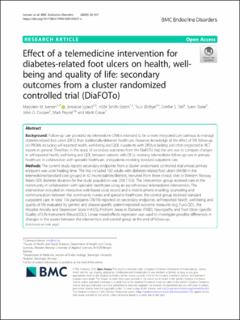| dc.contributor.author | Iversen, Marjolein M. | |
| dc.contributor.author | Igland, Jannicke | |
| dc.contributor.author | Smith-Strøm, Hilde | |
| dc.contributor.author | Østbye, Truls | |
| dc.contributor.author | Tell, Grethe S. | |
| dc.contributor.author | Skeie, Svein | |
| dc.contributor.author | Cooper, John | |
| dc.contributor.author | Peyrot, Mark | |
| dc.contributor.author | Graue, Marit | |
| dc.date.accessioned | 2020-12-29T11:55:11Z | |
| dc.date.available | 2020-12-29T11:55:11Z | |
| dc.date.created | 2020-11-09T12:56:04Z | |
| dc.date.issued | 2020 | |
| dc.identifier.citation | Iversen, M. M., Igland, J., Smith-Strøm, H., Østbye, T., Tell, G. S., Skeie, S., Cooper, J. G., Peyrot, M., & Graue, M. (2020). Effect of a telemedicine intervention for diabetes-related foot ulcers on health, well-being and quality of life: secondary outcomes from a cluster randomized controlled trial (DiaFOTo). BMC Endocrine Disorders, 20(1). | en_US |
| dc.identifier.issn | 1472-6823 | |
| dc.identifier.uri | https://hdl.handle.net/11250/2721055 | |
| dc.description.abstract | Background
Follow-up care provided via telemedicine (TM) is intended to be a more integrated care pathway to manage diabetes-related foot ulcers (DFU) than traditionally-delivered healthcare. However, knowledge of the effect of TM follow-up on PROMs including self-reported health, well-being and QOL in patients with DFUs is lacking and often neglected in RCT reports in general. Therefore, in this study of secondary outcomes from the DiaFOTo trial, the aim was to compare changes in self-reported health, well-being and QOL between patients with DFUs receiving telemedicine follow-up care in primary healthcare in collaboration with specialist healthcare, and patients receiving standard outpatient care.
Methods
The current study reports secondary endpoints from a cluster randomized controlled trial whose primary endpoint was ulcer healing time. The trial included 182 adults with diabetes-related foot ulcers (94/88 in the telemedicine/standard care groups) in 42 municipalities/districts, recruited from three clinical sites in Western Norway. Mean (SD) diabetes duration for the study population was 20.8 (15.0). The intervention group received care in the community in collaboration with specialist healthcare using an asynchronous telemedicine intervention. The intervention included an interactive web-based ulcer record and a mobile phone enabling counseling and communication between the community nurses and specialist healthcare; the control group received standard outpatient care. In total 156 participants (78/78) reported on secondary endpoints: self-reported health, well-being and quality of life evaluated by generic and disease-specific patient-reported outcome measures (e.g. Euro-QOL, the Hospital Anxiety and Depression Scale (HADS), Problem Areas in Diabetes (PAID), Neuropathy and Foot Ulcer–Specific Quality of Life Instrument (NeuroQOL)). Linear mixed-effects regression was used to investigate possible differences in changes in the scores between the intervention and control group at the end of follow-up.
Results
In intention to treat analyses, differences between treatment groups were small and non-significant for the health and well-being scale scores, as well as for diabetes-related distress and foot ulcer-specific quality of life.
Conclusions
There were no significant differences in changes in scores for the patient reported outcomes between the intervention and control group, indicating that the intervention did not affect the participants’ health, well-being and quality of life. | en_US |
| dc.language.iso | eng | en_US |
| dc.publisher | Springer Nature | en_US |
| dc.rights | Navngivelse 4.0 Internasjonal | * |
| dc.rights.uri | http://creativecommons.org/licenses/by/4.0/deed.no | * |
| dc.subject | Diabetic foot | en_US |
| dc.subject | Psychological aspects | en_US |
| dc.subject | Health care delivery | en_US |
| dc.subject | Clinical trials | en_US |
| dc.title | Effect of a telemedicine intervention for diabetes-related foot ulcers on health, well-being and quality of life: secondary outcomes from a cluster randomized controlled trial (DiaFOTo) | en_US |
| dc.type | Peer reviewed | en_US |
| dc.type | Journal article | en_US |
| dc.description.version | publishedVersion | en_US |
| dc.rights.holder | © The Author(s). 2020 | en_US |
| dc.source.pagenumber | 1-8 | en_US |
| dc.source.volume | 20 | en_US |
| dc.source.journal | BMC Endocrine Disorders | en_US |
| dc.identifier.doi | 10.1186/s12902-020-00637-x | |
| dc.identifier.cristin | 1846135 | |
| dc.relation.project | The Norwegian Directorate of Health and Innovation Norway, the Western Norway Regional Health Authority: 911716, 911605 | en_US |
| dc.relation.project | Norwegian Diabetes Association: 2011,2012,2013 | en_US |
| dc.relation.project | Norges forskningsråd: 221065 | en_US |
| dc.source.articlenumber | 157 | en_US |
| cristin.ispublished | true | |
| cristin.fulltext | original | |
| cristin.qualitycode | 1 | |

